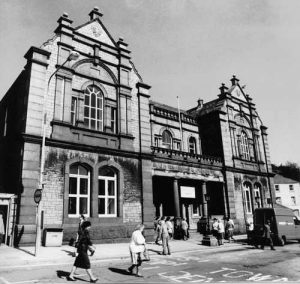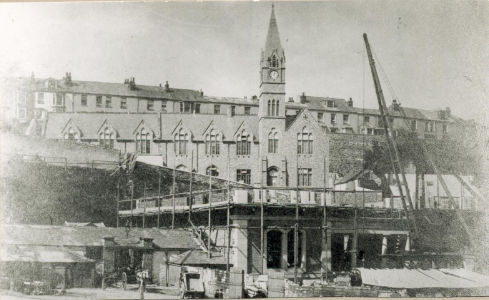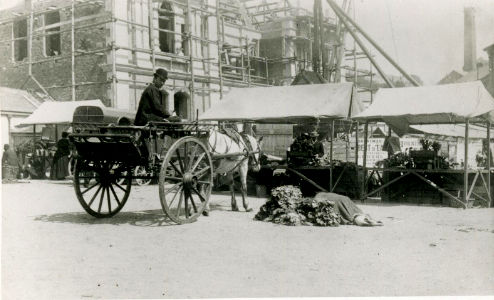The Library was incorporated into a new Municipal Building and an Arts and Science School.
Standing on one side of the market square, the Moor, the building retains its prominent position in the centre of the Town.

History
In September 1893 Passmore Edwards was presented with the honorary freedom of the Borough of Falmouth. During the celebratory dinner that followed, he said that as Cornwall was mainly surrounded by the sea, he should like to build a lighthouse at the Manacles. After consideration the Borough Council decided that they would rather have a library!
Following the adoption of the Free Libraries Act by the Falmouth Council in 1894, the Falmouth Free Library Authority was formed, under the Chairmanship of Alderman Thomas Webber. A penny rate raised £123. Passmore Edwards offered £2000 to match that earlier bequeathed to the Town by Octavious Allen Ferris. Passmore Edwards also gave 1000 books.
A building that would house the municipal offices as well as a Science and Technical Institute and the Library was agreed upon and the architects W H Tresidder and F J Bellamy (Borough Surveyor) were appointed. The Science & Art Department, in London, granted £420 towards the Science and Technical School and the Town Council provided £2000, £1800 of which was by means of loan raised with the sanction of the Local Government Board, for the Municipal Building.
A site situated in the centre of the town, on the side of the Market-Square (the Moor) and previously used as a pig market, was provided by the Town Council and the contract to build was awarded to a Mr Carkeek. The Building News, on 13 April 1894 reported “The front will be in Plymouth limestone, with Cornish granite dressings, and the remainder in local stone. Great care has been bestowed on the plans with the object of getting the maximum of accommodation and light. The fine entrance hall, staircase, and newspaper-room will form attractive features, and ample space has been given for the lending and reference libraries, above which are three commodious, well-lighted rooms for technical instruction, for which there is a great and growing want in Falmouth. One wing of the building will be devoted to municipal offices, with council chamber and anteroom”.


The Building Committee received a plan of a mantel piece to be presented to the library by Mr Bethnick MP.
The winter of 1894/5 was severe and building work on the new library building almost came to a halt on several occasions. Passmore Edwards laid the foundation stone on the same day as he opened the Falmouth Cottage Hospital, 13 April 1984. By February 1895 it was reported to the Town Council that ” The whole of the Municipal end was raised to the level of first floor, and a large portion of the building, including the portico, was built to the height of the cornice, a great part of which was in position”.
A temporary Library had been agreed by the Free Library Committee, in premises in Arwenack Street, and Alderman Thomas Webber, J.P., C.C, the Mayor, opened the reading room, on 2 April 1894. The lending library opened approximately a week later. All of the books donated by Passmore Edwards and other generous donors had been transferred to the temporary premises, and insured in the Royal Exchange in the sum of £350, and Mr and Mrs Brenton were appointed as caretakers, “to take charge of the premises in consideration of their having rooms, rent free, and for further remuneration for additional duties they might undertake.”
As with all public libraries at that time the books available for either reference or for lending were kept in a store room and the would be borrower, after studying the printed catalogue requested the chosen book from the library counter.. The temporary library opened with 1100 volumes of books and 25 daily and weekly magazines and newspapers. The Mayor undertook to provide for the newspapers for the first 6 months. The success of the Library was immediate. In 1894 there were 604 borrower tickets and 1,200 books a month were being issued at a rate of between 50 and 150 a day. By the end of the first year the number of books available had risen to 1,552, 150 of which were in the reference library, together with over 25 newspaper and Magazine titles in the reading room. Nathaniel Fox presented many gifts of books and Magazines.
The Bye law Committee of the Town Council prepared the necessary Bye laws & Regulations, which included that only persons over the age of 14 could use the reading room, which was open from 9am to 9pm six days a week, or lending library, open initially 3 times a week (Monday and Saturday, 6-9 in the eve and Wednesday 11am until 1pm).
The Rules stated that “Burgesses (electors) or persons resident in the Borough of Falmouth are alone entitled to borrow books from the lending library”. Burgesses were entitled to borrow books after signing an undertaking to replace or pay for any book lost or damaged. Other residents were only allowed to borrow books if they could obtain the signature of a “Burgess” as guarantor. A burgess could sign for no more than 4 other borrowers. Persons resident within 5 miles of the Borough boundary could also enroll on the payment of a subscription of 5/- per year, provided, again, that a “burgess” would sign their application.
The temporary library finally closed on 28 March 1896 and the books were transferred to the new premises on the Moor. Passmore Edwards donated a further £100 towards the library furniture. The Buildings were formally opened on 1 May 1896. With the opening of the new building the popularity increased and within the year to April 1897, 19,389 books had been borrowed
In 1897 the authority agreed to take over responsibility for the Library for the Blind which was then moved from the Polytechnic Hall to the Free Library. During that year permission was also granted for shorthand classes to be run in the Reference Library on Tuesday evening but these were short-lived as it is recorded that they ceased the next year.
When the post of Library Clerk was advertised at £20/yr. [9am to 9pm except Tues (6pm) & Fri (1pm)]. 6 applicants were interviewed by the Exchequer & Finance Committee with the Mayor in chair. Florence Basher was appointed at £13/yr and this was increased by 2s per week (10p) in 1901. This was obviously not entirely to Miss Basher’s satisfaction as she left shortly afterwards to be replaced by a Miss Jago. Miss Jago left in 1902 to be replaced by Miss Lowry. Meanwhile Mr Brenton continued to serve the Library, now as Sub Librarian.
A history of the Science, Art and Technical School may one day be separately presented but it is noted that in 1898 there was a request that the library reading room should be made over for the school’s use in exchange for a replacement room to be built to the North of the building.
Architects W H Tresidder and F J Bellamy (Borough Surveyor). No further information available.
Current Use
The library remains open but now under the control of the Falmouth Town Council.